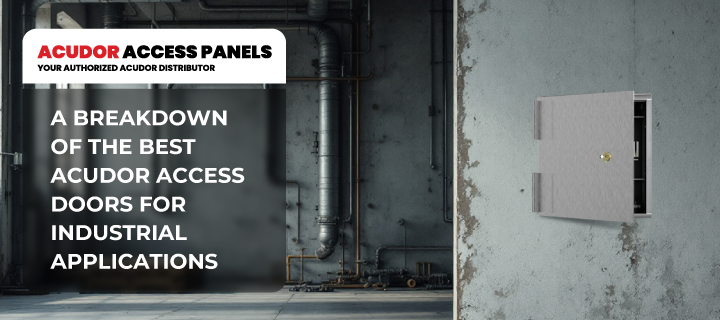What Are the Installation Requirements for Acudor Access Panels in Commercial Buildings? Posted by Acudor Access Panels on 22nd Nov 2024
Proper sizing, secure mounting, and adherence to manufacturer guidelines and building codes are essential for safe and effective installation. Acudor access panels, often used in commercial buildings for easy access to electrical, plumbing, and HVAC systems, require specific installation considerations.
This guide covers the key installation requirements, common challenges, and practical solutions to help facility managers and contractors ensure compliant, durable installations of Acudor access panels.
1. Building Codes and Regulations
Meeting local and national building codes and regulations is important for ensuring the safety and compliance of Acudor access panel installations.
Local Building Codes
Local building codes can vary significantly between jurisdictions. It's important to consult local building officials to determine specific requirements for panel size, material, fire rating, and installation methods. Some local codes may have more stringent regulations than national codes, so it's important to be aware of these differences.
National Building Codes
The International Building Code (IBC) and other national building codes provide general guidelines for access panel installation in commercial buildings. These codes often establish minimum standards for panel size, weight capacity, accessibility, and fire resistance.
Acudor Access Panels' PS-5030 flush access door, for instance, can help meet building code requirements by providing a seamless, unobtrusive access point. This design makes them ideal for commercial buildings where aesthetics and accessibility are priorities.
2. Structural Integrity
For a secure and long-lasting installation, assess the structural integrity of the wall or ceiling where the access panel will be mounted. The structure's load-bearing capacity must be sufficient to support the weight of the panel, including any equipment it may conceal. Carefully consider factors like panel size, material, and the weight of the equipment.
Additionally, the spacing of studs or joists must be compatible with the panel dimensions. If necessary, you can also reinforce the frames or contact us for custom panel sizes to ensure proper fitting and support.
3. Electrical and Mechanical Considerations
Proper clearance around the access panel is essential for efficient maintenance and repairs. Provide adequate space to access and work on electrical, plumbing, or HVAC systems.
It is also crucial to avoid obstructions like pipes, cables, or ductwork that could hinder access or damage the panel. By ensuring sufficient clearance, facility managers can streamline maintenance tasks and minimize downtime.
4. Fire Ratings
Fire-rated access panels help maintain building code compliance in areas with stringent fire regulations. The appropriate fire rating for a panel depends on factors like the building's occupancy, construction type, and local fire codes. Select a panel with a fire rating that meets or exceeds these requirements.
Additionally, a fire-rated sealant is important to preserve the wall or ceiling's fire rating. This specialized sealant forms a fire-resistant barrier around the panel, delaying the spread of flames and smoke for a certain period. However, correct sealant application is crucial to ensure its effectiveness and compliance with NFPA 80 standards.
5. Accessibility
Proper panel placement facilitates access and reduces maintenance costs. Install panels in easily accessible locations, considering panel height, visibility, and proximity to maintenance points. Avoid placing them in hard-to-reach areas or behind obstructions.
Ergonomic considerations should also be taken into account. Choose user-friendly panels that reduce strain on technicians and users. Optimal panel height and accessibility angles can reduce physical stress and improve efficiency.
Looking for user-friendly access panels that prioritize accessibility? Acudor Access Panels offers a range of solutions designed to simplify maintenance and improve efficiency. Contact our experts or browse our best sellers to find the perfect solution for your project.
6. Security Considerations
Although accessibility is important, unauthorized access to critical equipment or systems could pose a risk. A security access door can prevent this issue.
To further enhance safety, ensure the access panel is in a secure area and limit access to authorized personnel. Like the PS-5030 flush access door, we have access doors and panels with multiple lock options, providing an extra layer of protection.
Additionally, choose access doors and panels equipped with tamper-resistant hardware. This design will deter unauthorized access and tampering, safeguarding sensitive equipment and systems. With their added security, these solutions are ideal for commercial construction projects.
7. Aesthetics
Aesthetics play a significant role in a building's overall appearance. Choose panel finishes that blend seamlessly with the surrounding environment. Consider factors like paint color, material, and texture to achieve a cohesive look.
Opt for flush access panels with concealed hardware to maintain a sleek and clean appearance. This design enhances the aesthetics and protects the hardware from damage and tampering.
8. Installation Tools and Materials
Installation won't be successful without the right tools and materials. Essential tools include drills, screwdrivers, saws, levels, and other basic tools. Using appropriate tools will ensure a safe and efficient installation process.
It's crucial to use the hardware the manufacturer provides or consult their instructions for specific requirements. High-quality hardware is essential for a secure and durable installation.
To Sum Up
Proper installation of Acudor access panels is essential for ensuring easy access to building systems, minimizing downtime, and maintaining a professional appearance.
By considering panel size, fire rating, accessibility, and security, you can achieve successful installations that enhance building maintenance and operations. Remember to adhere to local building codes, use high-quality materials, and follow the manufacturer's guidelines for optimal results.
Acudor Access Panels is a trusted and authorized distributor of Acudor products. We are proud to bring you their full range of industry-leading access doors and panels.





